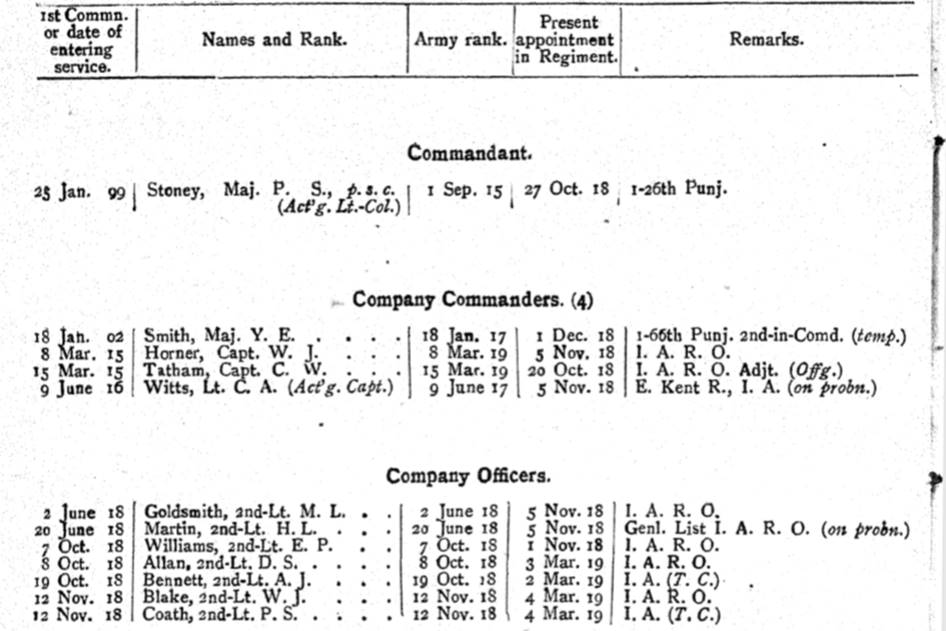This article on the 2nd Battalion 66th Punjabis aims to help you research either the Battalion or a soldier who served with it during the First World War. I have also written a separate article for the 1st Battalion 66th Punjabis and have created a series of guides to help you research soldiers who served in the Indian Army during the First World War. The links below will take you to the guides:
- Guide to the 1st Battalion 66th Punjabis
- Guides to Researching Soldiers who Served in the Indian Army
The 2nd Battalion 66th Punjabis in the First World War
Lineage: The 2nd Battalion 66th Punjabis was formed at Sitapur (Uttar Pradesh, India) on 5 October 1918 and disbanded on the 22nd July 1922. For a history of the Regiment’s lineage see my page on the 1st Battalion 66th Punjabis.
Class Composition of Battalion in 1919: 2 Companies of Punjabi Muslims and 2 Companies of Oudh Rajputs.
The 2nd Battalion 66th Punjabis was a short-lived, war-raised Indian infantry battalion formed at Sitapur (Uttar Pradesh, India) on 5 October 1918. The Battalion’s commanding officer was Acting Lieutenant-Colonel Patrick Sinclair Stoney who was appointed from the 26th Punjabis on 27 October 1918. Stoney had first been commissioned in January 1899, served with the 26th Punjabis since 1900 and had seen active service on the Mohmand Expedition in 1908. The majority of British Officers who served with the Battalion were recently commissioned Indian Army officers or were drawn from the Indian Army Reserve of Officers. The extract below was taken from the April 1919 Indian Army List and recorded the British officers serving with the Battalion.

General remarks: The men carry their arms well and all ranks work steadily and without noise. Colonel Stoney is a staff college man and knows how to command; he is well backed up by officers and men and has a good battalion.
Confidential review reports on Indian Army units, depots, British officers, etc. for 1918-1919: IOR/L/MIL/7/17030.
The Battalion received a “very satisfactory report” and was seen as one of the more efficient war-raised Indian units. The Battalion was inspected again in late 1919, by Brigadier-General Reginald Edward Dyer, Commanding 5th Brigade and Major-General Dobell, Commanding 2nd Division. Dobell reported:
A good system of training exists in the battalion and instruction is being carried out on sound lines. The battalion is well commanded and the well being of the men receives every attention. The defects brought to notice in certain officers must improve or the officers be got rid of.
The Battalion later served overseas, with its Depot based at Benares (Varanasi, India). The Battalion was disbanded on 22nd July 1922.
War Diaries of the 2nd Battalion 66th Punjabis
Unfortunately, there are no war diaries for the 2nd Battalion 66th Punjabis.
Further Sources of Information for the 2nd Battalion 66th Punjabis
For information regarding the British and Indian officers of the 2nd Battalion 66th Punjabis, the Indian Army List should be consulted. The Confidential Reports for the Battalion can be found at the British Library which also report on the British officers serving with it:
- Confidential review reports on Indian Army units, depots, British officers, etc. for 1918-1919: IOR/L/MIL/7/17030.
- Confidential review reports on Indian Army units, depots, British officers, etc. for 1919-1920: IOR/L/MIL/7/17031.
- Confidential review reports on Indian Army units, depots, British officers, etc. for 1920-1921: IOR/L/MIL/7/17032.
